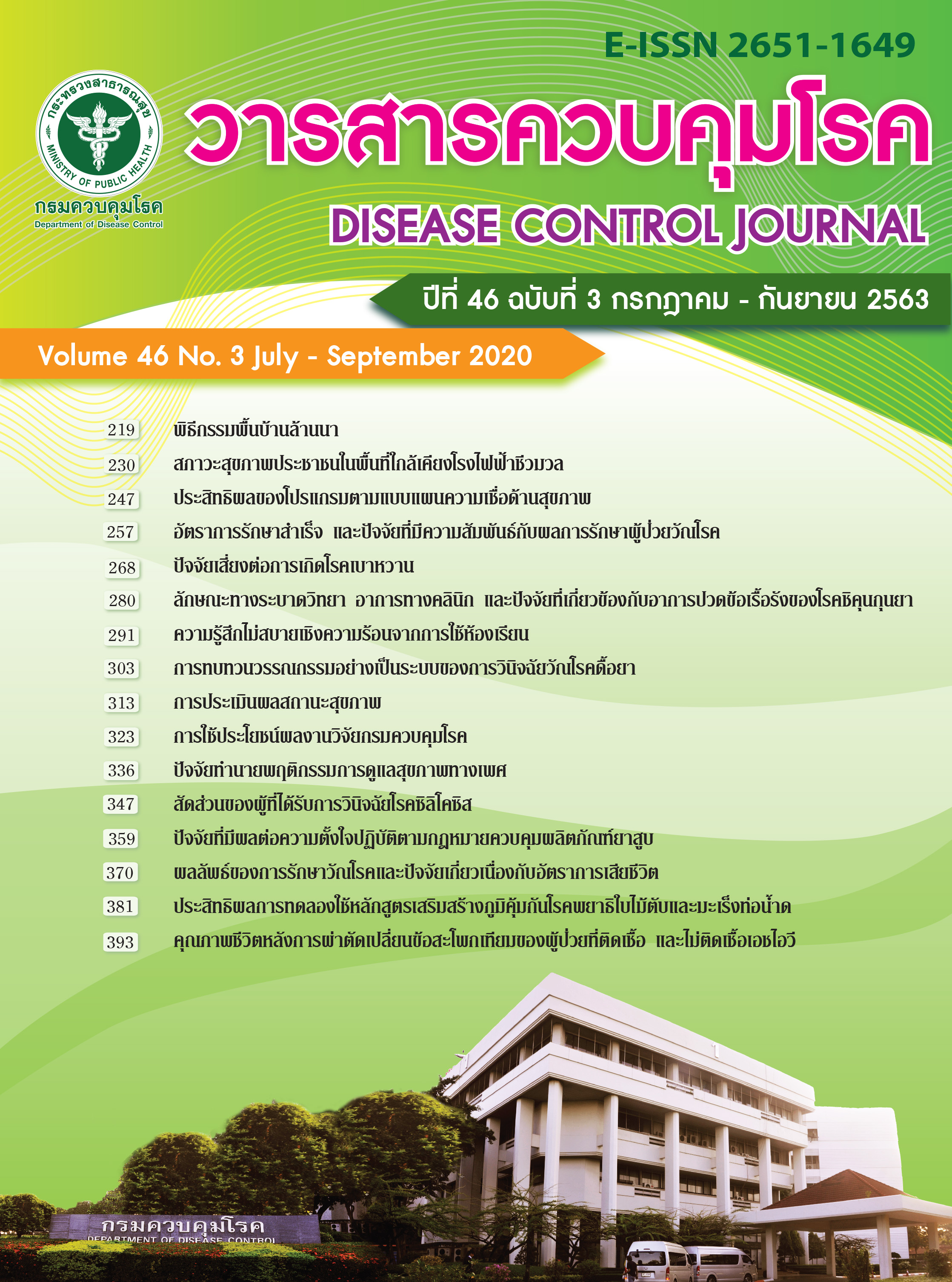Predicting factors of sexual health care behaviors among male adolescents in eastern region, Thailand
DOI:
https://doi.org/10.14456/dcj.2020.32Keywords:
Predicting factors, sexual health care behaviors, male adolescentsAbstract
This cross-sectional descriptive research aimed to study predicting factors of sexual health care behaviors among male adolescents in Eastern Region, Thailand. A multi-stage random sampling was used to recruit 395 male adolescents aged 18 year old and above from universities in the eastern region of Thailand. Five-parts questionnaire was tested for reliabilities which were between 0.704 - 0.776. Data were analyzed by using descriptive statistics and stepwise multiple regression analysis. The results revealed that half of them had fair level of sexual health care behaviors. For stepwise multiple regression analysis, there were significant predictors of sexual health care behaviors and accounted for 29.3 % (R2 = 0.293, p<0.01) as following; perceived benefit to STDs/AIDS prevention ( = 0.291), self-efficacy to safe sex (
= 0.239), perceived barrier to STDs/AIDS prevention (
= - 0.203), heterosexual males (
= 0.159), and good family relations (
= 0.122). The findings suggested that public health officers and related staffs in the university should apply innovative strategies to promote sexual health care behaviors for male adolescents in universities focusing on perceived benefits, and barriers to STDs/AIDS prevention, self-efficacy for safe sex, preventive sexual risk behaviors especially in homosexual male adolescents, and good family relations.
Downloads
References
2. Bureau of Epidemiology, Department of Disease Control, Ministry of Public Health. Guidelines for surveillance system analysis of 5-dimensional diseases, 2016. Bangkok: TS Interprint Co., Ltd.; 2016. (in Thai)
3. Ministry of Public Health, Department of Disease Control. National disease surveillance (Report 506), 2008–2015. Nonthaburi: Bureau of Epidemiology; 2015. (in Thai)
4. Bureau of Epidemiology, Department of Disease Control, Ministry of Public Health. Surveillance behaviors associated with HIV infection among students in Thailand, 2014. Bangkok: Aksorn Graphic & Design Co., Ltd; 2015. (in Thai)
5. Bureau of Epidemiology, Department of Disease Control, Ministry of Public Health. Surveillance behaviors associated with HIV infection among students in Thailand, 2015. Bangkok: Aksorn Graphic & Design Co., Ltd; 2016. (in Thai)
6. Ministry of Public Health, Department of Disease Control. Result of promoting condom use project, 2012 - 2015. Nonthaburi: Bureau of AIDS, TB and STIs; 2015. (in Thai)
7. Cochran WG. Sampling Techniques. 3rd edition. New York: John Wiley & Sons; 1997.
8. Bloom BS., et al. Hand book on formative and summative evaluation of student learning. New York: Mc Graw-Hill Book Company; 1971.
9. Pawaree W. Preventive behavior on sexually transmitted diseases by condom of people in watsisuk community, Chomthong District, Bangkok Metropolitan Administration. APHEIT Journal; 2014, 20(2): 148-157. (in Thai)
10. Li Xianhong, Lei Y, Wang H, He G, Williams AB. The health belief model: A qualitative study to understand high-risk sexual behavior in chinese men who have sex with men. Journal of the Association of Nurses in AIDS Care; 2016, 27(1): 66-76.
11. Chondaeng K, Rutchanagul P, Buaboon N. Factors influencing HIV preventive behaviors among male adolescents in a correctional institution. Journal of Nursing and Health Care; 2018, 36(1): 43-51. (in Thai)
12. Rosenstock IM, Strecher VJ, Becker MH. Social learning theory and the health belief model. HE&B; 1988, 15(2): 175-183.
13. Isaro N, Toonsiri CH, Srisuriyawet R. Factors predicting appropriated sexual behaviors among the lower secondary school students in Chanthaburi Province. The Journal of Faculty of Nursing Burapha University; 2016, 24(2): 72-84. (in Thai)
14. Pented P, Chomson S. Factors affecting protection of sexual risk behaviors among high school students in Banklang Subdistrict, Wangthong District, Phitsanulok Province. Boromarajonani College of Nursing, Uttaradit Journal; 2019, 11(2): 62-79. (in Thai)
15. Watronachai N, Kredmongkol P, Powwattana A, Khan P. Safer sex practices among male vocational students in Nakhon Pathom province. Journal of Health Science; 2007, 1(1): 38-46. (in Thai)
16. Chudjuajeen S, Singhasame P, Wuttisukpaisan S. Effects of perceived self-efficacy promoting program for life skill enhancement on sexual health behavior of students. The Southern College Network Journal of Nursing and Public Health; 2017, 4(2): 268-280. (in Thai)
17. Bandura A. The nature and structure of self-efficacy, source of self-efficacy: The exercise of control. New York: W.H. Freeman; 1997.
18. Brian CT. Parental monitoring among young men who have sex with men: Associations with sexual activity and HIV-related sexual risk behaviors. Journal of Adolescent Health; 2017, 61(3), 348-354.
19. Wongpanarak N, Siriwattanamethanon J. Perception of homosexuality in adolescent males. Journal of nurses’ association of Thailand, north-eastern division; 2012, 30(3): 42-49. (in Thai)
20. Promma N, Suparp J, Chamroonsawasdi K, Theachaboonsermsak P, Tansakul S. Factors predict intentions to have premarital sexual amongst freshman college male students. Naresuan Phayao Journal; 2013, 6(2): 157-167. (in Thai)
21. Yatha G, Sivabaedya S. Family relationship affecting adolescent’s tendency to have premarital sexual relation. Journal of Education (Graduate Studies Research), Khon Kaen University; 2013, 7(2): 11-22. (in Thai)
22. Farahani FK, Johns C, Amir HM. Associations between family factors and premarital heterosexual relationships among female college students in Tehran. International perspectives on sexual and reproductive health; 2011, 37(1), 30-39.
23. Tsala ZD, Defo BK. Family environment and premarital intercourse in Bandjoun (West Cameroon). Arch Sex Behav; 2011. 41(2): 351-361.
24. Adam AR, Thao H, Elizabeth AS, Thomas JD. Quality of parent–adolescent conversations about sex and adolescent sexual behavior: An observational study. Journal of Adolescent Health; 2015, 57(2), 174-178.
25. Daphne B, Hanneke G, Ellen R, Maja D. Parents as moderators of longitudinal associations between sexual peer norms and dutch adolescents' sexual initiation and intention. Journal of Adolescent Health; 2014, 55(3), 388-393.
Downloads
Published
How to Cite
Issue
Section
License
Articles published in the Disease Control Journal are considered as academic work, research or analysis of the personal opinion of the authors, not the opinion of the Thailand Department of Disease Control or editorial team. The authors must be responsible for their articles.






